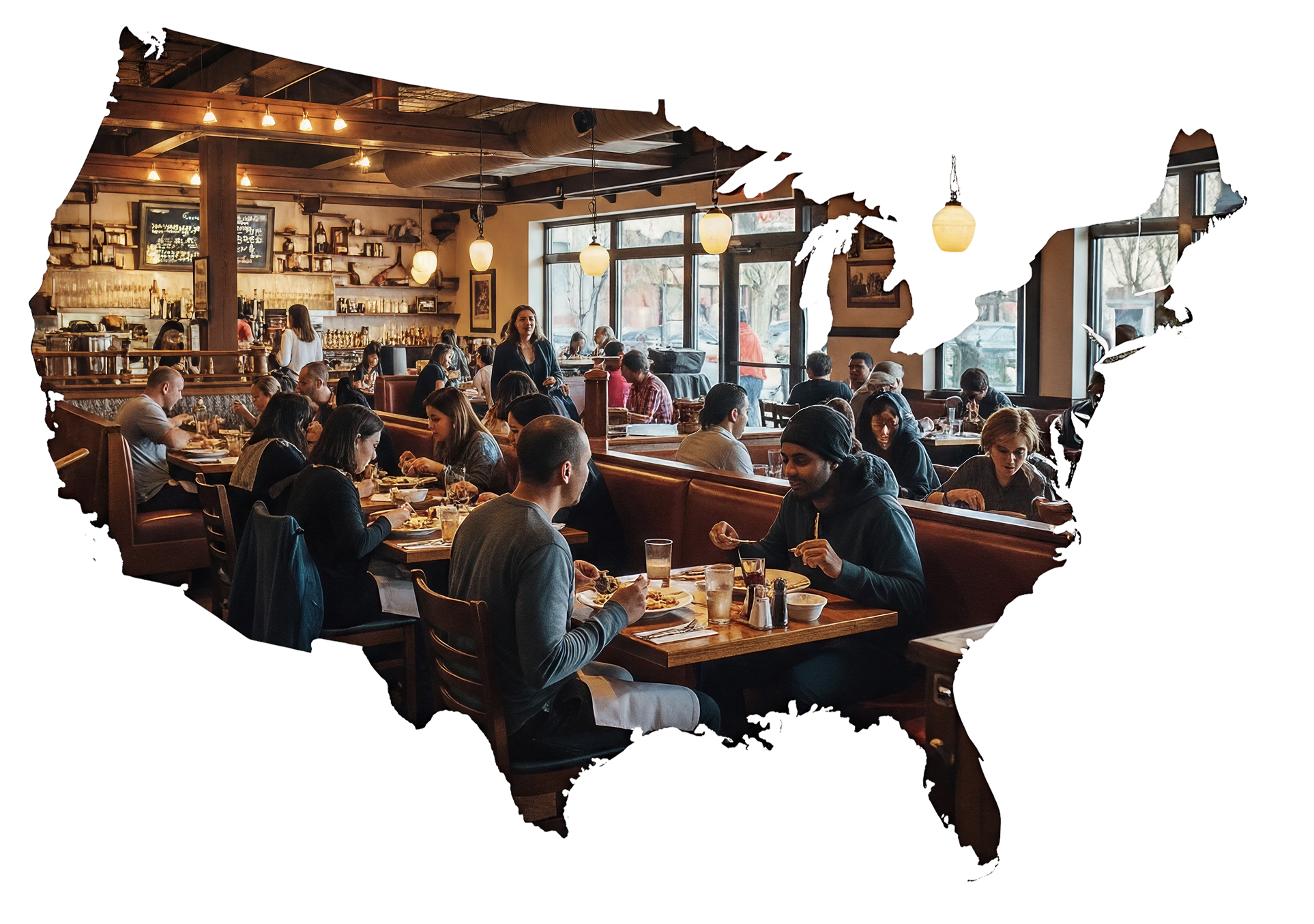Top Growing and Declining Full-Service Restaurant Markets in 2025

Fastest-Growing vs. Declining Full-Service Restaurant Markets (2024–2025 Outlook)
Full-service restaurants (FSR) – sit-down eateries with table service – are rebounding globally, but growth is very uneven by country. This report highlights the top 5 fastest-growing FSR markets and the top 5 most declining (or slow-growing) FSR markets, based on revenue trends and forecasts for 2024–2025 and beyond. We focus exclusively on full-service restaurants (excluding quick-service and other formats), citing the latest available data and industry projections. Key macro drivers – from tourism booms and rising middle classes to aging populations and inflation – are discussed for each country.
Summary Table: Top 5 Growing vs. Declining FSR Markets
| Country | 2024 FSR Revenue / Growth | 2025–2030 Outlook |
|---|---|---|
| India (Growing) | ~$70 B (2023/24 total foodservice market); FSR segment surging | Projected ~$95.7 B total by 2025 (≈10% CAGR); fueled by rising middle class and urbanization |
| Indonesia (Growing) | ~$29 B in 2024 (FSR sales), up from ~$24 B in 2022 | ~13% annual growth in foodservice to 2030; large youth population and tourism driving FSR |
| Vietnam (Growing) | ~$21.9 B in 2024 (foodservice market value) | ~9.7% CAGR (2025–2033); young consumers, urban dining culture boosting full-service demand |
| Saudi Arabia (Growing) | Est. ~$30 B in 2024 (FSR market); rapid growth underway | ~$46.8 B by 2030 (8.6% CAGR 2024–30); driven by higher incomes, a young population, and tourism (Vision 2030) |
| UAE (Growing) | +47% YoY revenue jump in Dubai’s fine-dining segment (early 2024) | Strong tourism strategy (Tourism 2031) fueling continued FSR expansion in UAE’s cities (Dubai, Abu Dhabi) |
| United Kingdom (Declining) | –6.7% restaurant spending in 2023 as consumers cut back | Outlook muted; cost-of-living pressures pushing diners toward cheaper options (pubs +5.9%, fast food +8.1% in 2023) |
| Germany (Declining) | –2.6% real revenue drop in 2024 despite +0.6% nominal uptick | High inflation and VAT hikes dampen FSR recovery; 2024 sales still ~15% below 2019 in real terms |
| Italy (Declining) | Protracted recovery; 2019–2024 FSR market –10.3% CAGR (incl. takeaways) | Slow rebound post-pandemic; aging population and economic stagnation limit long-term FSR growth (tourism helps somewhat) |
| Japan (Stagnant) | 2023 FSR sales ~back to 2019 level (~$21.5 B chained FSR) | Minimal growth ahead (~3.0% CAGR thru 2028); an aging society and labor shortages cap FSR expansion |
| United States (Flat) | $855 B total foodservice in 2023; –0.1% real growth vs 2022 | Moderate growth resumed in 2024, but full-service segment faces saturation and high operating costs (real growth near 0%) |
Top 5 Fastest-Growing FSR Markets
1. India – Booming Domestic Demand
India’s full-service restaurant sector is one of the world’s fastest-growing, propelled by a massive population and rising incomes. India’s overall foodservice market was about $70 billion in 2023 and is forecast to reach nearly $95.8 billion by 2025, roughly a 10% annual growth rate. This rapid expansion is underpinned by strong macro drivers: a growing middle class and urbanization, a youthful demographic with increasing disposable income, and a surge in dining-out culture. Industry analyses note that India’s restaurant industry is growing “geometrically,” thanks to the “mega population” and rising tourism. Full-service establishments (especially casual dining) are expanding in both major metros and smaller cities. The National Restaurant Association of India projects robust growth as more informal eateries formalize and new organized chains enter the market. Overall, India’s FSR outlook for the next 5–10 years is very positive, with double-digit growth driven by demographics and economic development.
2. Indonesia – Post-Pandemic Rebound and Rising Middle Class
Indonesia’s full-service restaurant industry is experiencing strong recovery and growth. In 2024, FSR sales reached approximately $29 billion, up from around $24 billion in 2022. This resurgence follows the pandemic dip – the FSR sector’s value fell in 2020–21 – and reflects renewed consumer confidence in dining out. Independent restaurants have led the comeback, sustaining positive sales even as some chained outlets saw slower growth. Longer-term, Indonesia’s large, young population and expanding middle class bode well for FSR demand. Full-service restaurants made up about 54% of Indonesia’s foodservice market in 2022, indicating their cultural importance. Industry forecasts predict Indonesia’s overall foodservice market will grow ~13% annually from 2025 to 2030 – one of the highest rates globally – and FSR will ride this wave. Key drivers include rapid urbanization, evolving consumer preferences, and tourism. The country welcomed over 7 million international visitors in 2022, and tourism hotspots like Bali spur restaurant growth. Rising incomes are enabling more Indonesians to dine out frequently, so Indonesia is poised to remain a top-growth FSR market through the next decade.
3. Vietnam – Emerging Market with High Dining-Out Growth
Vietnam’s full-service dining segment is growing vigorously on the back of economic development and evolving lifestyles. The Vietnam foodservice market was valued around $21.9 billion in 2024 and is projected to more than double to ~$54 billion by 2033 (≈9.7% CAGR). This implies sustained high growth in restaurant revenues, including full-service formats. Rising urbanization and a young population (median age ~32) are driving more frequent dining out, while incomes have been climbing steadily. As Vietnam’s middle class expands, consumers are seeking diverse culinary experiences, boosting everything from local casual eateries to new foreign cuisine restaurants. Moreover, investment by international and local restaurant chains is accelerating the industry’s expansion. Macroeconomic tailwinds – GDP growth, tourism (pre-pandemic, Vietnam saw a tourism boom), and increasing consumer spending on food away from home – all support the robust outlook for full-service restaurants. Industry observers note Vietnam is “poised for continued growth” in F&B with nearly ~8–10% annual gains in coming years. Overall, Vietnam stands out as a fast-growing FSR market in Asia, fueled by demographics and economic trends similar to India and Indonesia.
4. Saudi Arabia – Rapid Growth Under Economic Diversification
Saudi Arabia’s full-service restaurant industry is expanding quickly, bolstered by government-led economic diversification and social changes. Saudi was the fastest-growing G20 economy in 2022, and higher incomes plus a young population are translating into greater demand for dining out. Industry forecasts show the Saudi restaurant market (overall) will reach about $46.8 billion by 2030, growing at ~8.6% CAGR from 2024–2030. Full-service formats, including upscale and casual dining, are major beneficiaries of this trend as lifestyles shift. Key drivers include a rising middle class, urbanization, and cultural shifts – younger Saudis are embracing restaurant culture, and women’s increased workforce participation means more households eat out. The government’s Vision 2030 initiatives and tourism promotion (e.g. new entertainment hubs, relaxed social norms, booming religious tourism) are also fueling foodservice. For example, dine-in revenue in Saudi showed 7% volume growth in late 2023. While inflation is a factor globally, Saudi consumers’ purchasing power has grown, supporting higher restaurant spending. With continued investments (many Gulf-based hospitality groups are expanding restaurant franchises) and population growth, Saudi Arabia is expected to remain one of the fastest-growing FSR markets for the foreseeable future.
5. United Arab Emirates – Tourism-Fueled Restaurant Boom
The UAE – especially Dubai and Abu Dhabi – is experiencing a restaurant boom propelled by tourism and high consumer spending. Dubai in particular has seen a dramatic post-pandemic surge: in early 2024, fine-dining restaurant revenues in Dubai jumped over 47% year-on-year. This reflects a huge influx of tourists and returning business travel, as well as affluent local and expat diners. The UAE government’s ambitious Tourism Strategy 2031 aims to greatly increase visitor numbers, supporting further growth of full-service restaurants. Dubai has become a global dining destination, and its hospitality industry is expanding to meet demand – hundreds of new restaurants open yearly, from celebrity chef eateries to popular regional chains. Key drivers include strong GDP per capita, a large expatriate community with diverse culinary preferences, and proactive government support for the hospitality sector. The UAE’s focus on mega-events (Expo 2020, trade conferences, sports events) and luxury experiences also boosts FSR sales. While growth rates may normalize after the initial rebound, industry experts still see above-average growth ahead for UAE’s full-service dining: the market is set to benefit from sustained tourism growth, high disposable incomes, and investment in high-end restaurant concepts.
Top 5 Declining or Slowest-Growing FSR Markets
Top 5 Declining or Slowest-Growing FSR Markets
1. United Kingdom – Cost-of-Living Squeeze Cuts Dining Out
UK restaurant spending dropped 6.7% in 2023. Consumers have traded down to cheaper options like pubs or fast food. High inflation and energy costs have forced nearly 2,000 UK restaurants to close. Full-service restaurants are especially vulnerable when budgets tighten.
2. Germany – Inflation and Policy Challenges Stalling Recovery
In 2024, Germany’s FSR industry saw a 2.6% real revenue decline. Real turnover remains ~15.8% below 2019 levels. VAT hikes, food inflation, and recessionary pressures make the FSR sector among the slowest to recover.
3. Italy – Slow Recovery and Demographic Headwinds
Italy’s restaurant and takeaway market shrank ~10.3% CAGR between 2019–2024. An aging population, economic stagnation, and weak domestic demand hinder growth. Culinary tourism supports some recovery but doesn't offset deep-rooted structural weaknesses.
4. Japan – Mature Market with Limited Growth
FSR revenue in Japan has returned to near-2019 levels but is expected to grow just ~3.0% annually through 2028. An aging, shrinking population and labor shortages make growth difficult. The dining-out culture is shifting toward takeout and delivery.
5. United States – Saturation and Shifting Preferences
While the U.S. foodservice market reached $855 billion in 2023, real growth was −0.1%. The full-service segment is saturated. Consumers are gravitating toward QSR and home delivery. Rising rents and labor costs pressure margins, especially for mid-range chains.
Conclusion
The global full-service restaurant industry is experiencing a two-speed divergence. Emerging markets in Asia and the Middle East are growing rapidly due to favorable demographics and macroeconomic tailwinds. Meanwhile, many developed economies are struggling with stagnation or decline due to aging populations, inflation, and shifts in consumer behavior. Businesses must tailor strategies accordingly: invest and scale in high-growth regions, and innovate or streamline in mature ones.
Sources
- Statista: Restaurant and Foodservice Market Data
- Euromonitor International: Country Sector Reports
- IBISWorld: Country-specific restaurant market reports
- Mordor Intelligence: Global F&B Market Trends
- National Restaurant Association (USA)
- Barclays UK Consumer Spending Report
- Paperchase Middle East Hospitality Trends
- Reuters, The Munich Eye, The Hindu Business Line, Apicbase




